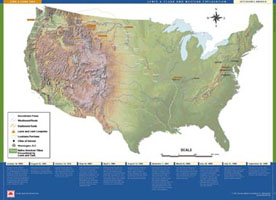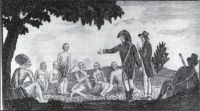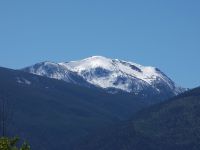Who Signed the Declaration of Independence How Old Was Sacagawea When She Had Her Baby

Boundaries of the Louisiana Purchase and Expedition Route
After Lewis returned to Washington from Philadelphia in the summer of 1803, the United States' purchase of the Louisiana territory from France was announced. Now the journey was even more than important. Lewis and his political party would be exploring state that belonged to the United states of america. Armed with Jefferson'due south letter of the alphabet of instructions, Lewis traveled to Pittsburgh and and so set out on the Ohio River. At Clarksville, in present-mean solar day Indiana, he met upwardly with William Clark. They packed the keelboat, which Lewis had designed, and two pirogues (canoe-similar boats) with supplies and headed downriver. They were accompanied by some recruited soldiers, Clark's African-American slave York, and Lewis'south Newfoundland dog Seaman.
Lewis and Clark spent the winter of 1803-04 at Camp Dubois on the east bank of the Mississippi River, upstream from St. Louis. Here the captains recruited more men, increasing the ranks of the "Corps of Volunteers for Northwest Discovery" to more xl. As spring approached, the members of the Expedition gathered food and supplies and packed them into barrels, bags, and boxes. The boats were loaded and the party made ready to depart. On May 14, 1804, the Lewis & Clark Expedition began its trip up the Missouri River.
Lewis, Clark, and other members of the Expedition began writing in their journals, a exercise that connected throughout the journey. Map-making was equally of import, especially in the previously unexplored regions. As the explorers encountered new rivers and streams, they were responsible for naming them. They named some for famous Americans, such equally Jefferson and James Madison, and others for friends and members of the Expedition. The aforementioned was true for some of the new plants and animals they encountered. Many of these names are still in employ today.
In late July the explorers camped north of the mouth of the Platte River, at a site they called Council Barefaced. Lewis noted in his periodical that the location was skillful for a trading mail service. Information technology was here on August iii that Lewis and Clark had their start council with Native Americans, a small group of Oto and Missouri Indians. During this time Sergeant Charles Floyd, 1 of the soldiers, became ill and died of a ruptured appendix on August 20. He was the but fellow member of the Expedition to dice during the journey.
As the Expedition traveled upward the Missouri River during tardily August and into September, the mural along the river changed drastically. The forests receded, replaced first by tall prairie grass and then the shorter grass of the high plains. Thousands of buffalo were seen grazing, and prairie dogs were first sighted. The evening temperatures became colder, with frost on the ground some mornings. Lewis and Clark planned to wintertime nigh long-established villages inhabited by large numbers of the Mandan and Hidatsa tribes, north of present-twenty-four hours Bismarck, North Dakota. On Oct 26, 1804, the Expedition arrived at the world-club Indian villages, approximately 1,600 miles from Camp Dubois. A good site was plant for a camp, and the men set about building Fort Mandan across the river from the Indian villages.
During the wintertime Lewis and Clark worked to found skilful relations with the Indians, who had been dealing with English and French-Canadian traders for some time. One of these traders, Toussaint Charbonneau, was persuaded to accompany the Expedition every bit an interpreter when it left in the spring. His young pregnant wife, Sacagawea, who had been captured from her Lemhi Shoshone tribe years before past Hidatsas, was to proceed too. Sacagawea thus became the simply female fellow member of the Trek. Her infant, named Jean Baptiste, was built-in on Feb 11, 1805. Lewis and Clark realized Sacagawea would be useful every bit a guide equally the Expedition proceeded west, and believed the presence of the woman and her child would signal that the party was a peaceful one.
During the cold winter at Fort Mandan, the members of the Expedition prepared a shipment that was to be sent back to President Jefferson. The shipment included maps, written reports, items fabricated past Native Americans, the skins and skeletons of previously unknown animals, soil samples, minerals, seeds, and cages containing a live prairie canis familiaris, a sharp-tailed grouse, and magpies. The large keelboat and virtually a dozen men were dispatched downriver on Apr seven. The shipment was received at the President's House in Washington iv months afterwards. Many of these items, including a painted Mandan buffalo robe, were eventually put on brandish in Jefferson'due south "Indian Hall," the foyer of Monticello, his home most Charlottesville, Virginia. Other objects were afterwards displayed in Charles Willson Peale's museum in Philadelphia. The same solar day the shipment was sent downriver, the "permanent party" of the Expedition left Fort Mandan in the two pirogues and six dugout canoes and headed westward into uncharted territory.
 Captains Lewis and Clark holding a Council with the Indians
Captains Lewis and Clark holding a Council with the Indians
Proceeding into present-day Montana, the explorers were amazed by herds of buffalo numbering more than 10,000 and by the ferocity of grizzly bears. On June thirteen, more than two months afterwards leaving Fort Mandan, the Expedition reached the Great Falls of the Missouri River, one of the greatest natural obstacles it would face. The falls gave off a thunderous roar, which emanated from a 10-mile stretch of river that dropped more than 400 feet over five cascades. The members of the Expedition unloaded the supplies from the boats and undertook a difficult overland portage effectually the falls.
In late July, the Expedition reached the Three Forks of the Missouri River then headed southwest, up the shallow, swift stream they named the Jefferson River. Sacagawea recognized Beaverhead Stone (northward of present-day Dillon, Montana) and said the political party was near the abode of her people, the Shoshone. Desperate to notice the Indians and their horses, Lewis decided to lookout ahead with 3 men. On August 12, Lewis ascended the final ridge to the Continental Separate on the Lemhi Pass (on the present-day border between Montana and Idaho). From the summit he expected to meet plains with a large river flowing to the Pacific Sea. Only when he reached the peak and looked due west, he came to the realization that there was no h2o route to the Pacific Ocean, but more than mountains.
 Bitterroot Mountains
Bitterroot Mountains
A few days later, Lewis came upon a Shoshone hamlet and tried to negotiate for horses needed to cross the daunting mountains. Clark and the rest of the Expedition arrived and Sacagawea was brought in to assist interpret. She was reunited with her brother, Cameahwait, the Shoshone chief. The explorers gear up camp well-nigh the Indian village and named it Camp Fortunate. The Shoshones provided the Expedition with some horses, a guide named Old Toby who had traveled through the mountains earlier, and data near mountain trails and other Indian tribes the explorers might encounter. The entire Expedition proceeded through the Lemhi Pass and made camp along a creek. This army camp was called Traveler'due south Residue.
Even though winter was fast budgeted and snow was roofing some of the peaks, Lewis and Clark decided to continue on through the Bitterroots, a range of the Rocky Mountains. Cameahwait had told them of a trail (Lolo Trail) used by the Nez Perce, a tribe that lived westward of the mountains. Unfortunately, the Expedition failed to locate this trail and spent many more days in the treacherous mountains than necessary. Temperatures dropped below freezing and the trail was steep and rocky. The men were fatigued and nutrient supplies were low, but the Expedition succeeded in making information technology across the mountains. One time out of the Bitterroots, the explorers fabricated canoes using the Indian method of burning out the inside of logs. Game was notwithstanding scarce, then Lewis and Clark purchased roots, fish, and dogs from the Nez Perce.
On Oct 7, the Expedition put five new canoes into the Clearwater River and, for the first time since leaving St. Louis, paddled downstream. The party went down the Clearwater and Snake Rivers to the Columbia River, which the explorers knew flowed into the Pacific Ocean. By the finish of October the Expedition had fabricated its way around the falls of the Columbia and sighted Mountain Hood. In November the Pacific Ocean was sighted. Clark estimated in his journal that the political party had traveled iv,162 miles from the mouth of the Missouri River.
 Scan of folio from a Lewis and Clark journal.
Scan of folio from a Lewis and Clark journal.
By Christmas, the men had nearly finished their winter quarters, which they called Fort Clatsop after the local Indian tribe. The explorers spent the cold, rainy, generally miserable wintertime updating their journals, trading with the Indians for food and other needed items, and preparing for the long render journey.
On March 23, 1806, Lewis and Clark presented Fort Clatsop to Chief Coboway (a Clatsop Indian) and the Trek began its expedition dwelling. The party reached the Nez Perce lands in May but had to look there until tardily June for the snows to melt on the Bitterroots. One time information technology crossed the mountains and reached Traveler's Rest, the Trek split up. Lewis took office of the men north and Clark led a political party downwards the Yellowstone River. On July 26, Lewis and his men get engaged in a fight with Blackfeet warriors, who were attempting to take horses and guns. Two of the warriors were killed. On Baronial 12, the unabridged Expedition was reunited at the indicate where the Yellowstone flows into the Missouri River.
Traveling with the Missouri's current, the Expedition was able to comprehend up to 70 miles in a day. The explorers reached the Mandan villages on August xiv, and there parted company with Charbonneau, Sacagawea, and young Jean Baptiste. The Expedition finished its journey when information technology reached St. Louis on September 23, 1806. President Jefferson had thought that the men would be gone for about a year, and consequently had feared for their safety. In fact, it took the Lewis and Clark Expedition 2 years, 4 months, and nine days to travel across the western part of the continent and back.
President Jefferson's instructions to Lewis were so all-encompassing as to exist almost impossible to fulfill, yet he viewed the Expedition every bit a tremendous success. The discoveries made by the explorers changed the vision of this immature country. No water route to the Pacific was found, but accurate and detailed maps were fatigued. Peaceful contact was made with Native American tribes and merchandise was discussed. The body of knowledge added to the scientific customs proved to be truly invaluable and vast reaches of N America had been explored. Lewis and Clark's "voyage of discovery" turned out to exist one of Thomas Jefferson'southward about enduring legacies.
hornbergeraffen1947.blogspot.com
Source: https://www.monticello.org/thomas-jefferson/louisiana-lewis-clark/the-journey-west/
0 Response to "Who Signed the Declaration of Independence How Old Was Sacagawea When She Had Her Baby"
Postar um comentário